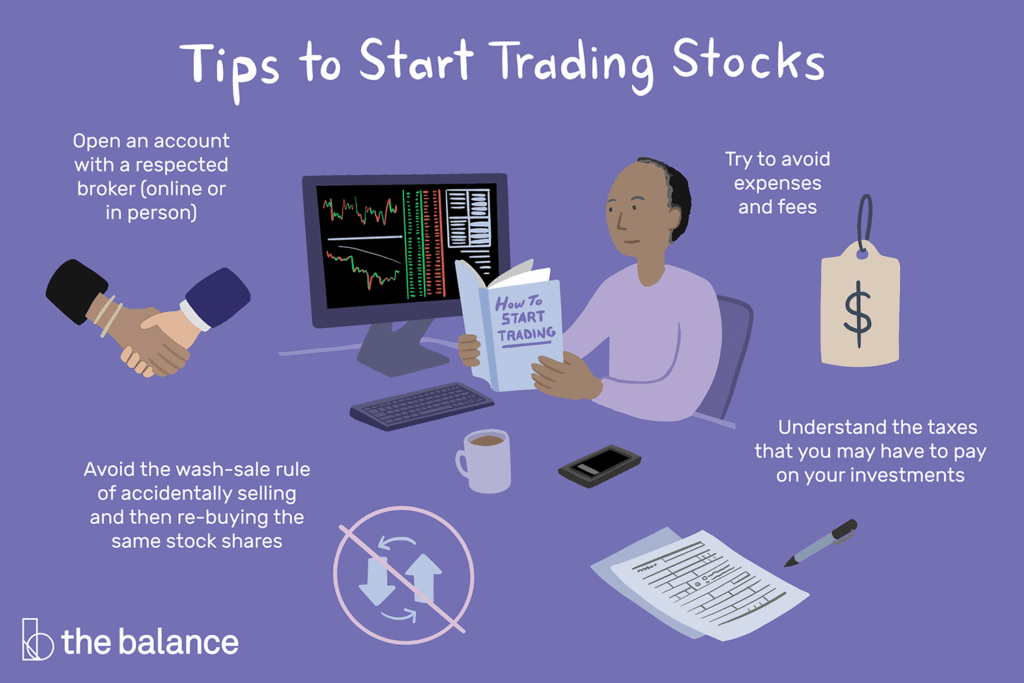Investing in stocks can be a rewarding way to grow your wealth over time, but it’s important to approach it with a well-thought-out strategy. Here’s a detailed step-by-step guide on how to invest in stocks, including essential tips to help you get started.
1. Set Financial Goals
Before you start investing, it’s crucial to determine your financial goals. Are you saving for retirement, building an emergency fund, or preparing for a major life event like home buying? Your goals will influence your investment strategy, including the types of stocks you choose and your investment horizon.
- Tip: Clearly define both short-term and long-term financial goals. For example, if you’re saving for retirement, consider how many years you have until retirement and what kind of growth you’ll need to achieve your goal. Setting specific, measurable goals will help you stay focused and make informed investment decisions


2. Build an Emergency Fund
Before diving into stock investing, ensure you have an emergency fund in place. This fund should cover 3-6 months of living expenses and be kept in a liquid, easily accessible account, such as a savings account. Having this cushion helps protect you from needing to sell your investments prematurely in case of unexpected expenses.
- Tip: Keep your emergency fund separate from your investment accounts. This ensures that the money is readily available in case of emergencies and not exposed to market risks. Avoid investing money that you might need in the short term, as stock markets can be volatile and may not provide quick returns when you need them.
- Two crucial points: 1. Only invest money you can afford to lose. 2. Never put yourself in a financially vulnerable position for the sake of investing.
3. Identify Your Risk Tolerance and Investment Strategy
Before you begin investing, assessing your comfort level with market risks is important, known as risk tolerance. You might have a higher risk tolerance if you’re comfortable with potential short-term losses in pursuit of long-term gains. Conversely, a lower-risk approach might be more suitable if market downturns make you uneasy.
- Tip: Evaluate your risk tolerance using online assessments or by consulting with a financial advisor, taking into account your age, income, and financial goals.
Your risk tolerance will help determine your investment strategy:
- Conservative: Prioritizes safety with investments like bonds and blue-chip stocks.
- Moderate: Balances risk with a mix of stocks and bonds.
- Aggressive: Seeks high returns with growth-focused stocks, suitable for those willing to take on more risk.
Understanding your investing style is key when learning how to invest in stocks and selecting the right investment approach. Some investors prefer an active, hands-on strategy, while others favour a passive, set-it-and-forget-it method. Your style may evolve over time, but it’s important to start with an approach that suits your current preferences.


DIY Investing:
- Active: Manage your trades directly through a brokerage, setting your own goals and deciding when to buy or sell.
- Passive: Invest in index ETFs or mutual funds through your brokerage, where fund managers handle the trading.
Professional Guidance:
- Work with a financial advisor or broker who provides personalized advice, monitors your portfolio, and helps you adjust your strategy as needed.
4. Choose a Brokerage Account
To buy and sell stocks, you’ll need to open a brokerage account. Various online brokers offer different features, fee structures, and tools. Look for a brokerage that offers a user-friendly platform, low fees, and features that match your investment style.
- Tip: Compare brokers based on trading commissions, account fees, research tools, and customer service. If you’re new to investing, consider a brokerage that offers educational resources and a straightforward platform. Decide whether you prefer a full-service broker, which provides personalized advice, or a discount broker if you’re comfortable making decisions on your own.
Consider the tax implications:
- Taxable accounts: These are the most common if you’re trading online. Brokerage accounts don’t offer tax benefits, but there are no restrictions on contributions or withdrawals.
- Tax-deferred accounts: Contributions to traditional IRAs and 401(k)s cut taxable income, and taxes are deferred until you withdraw the money.
- Tax-free accounts: Roth IRAs and Roth 401(k)s are funded with after-tax dollars, but qualified withdrawals in retirement are tax-free.
5. Start Small: How to Invest in Stocks
If you’re new and learning how to invest in stocks, it’s wise to start with a small amount of money. Many brokerages now allow you to buy fractional shares, enabling you to invest in expensive stocks like Apple or Amazon for as little as $1.
- Tip: Starting small helps you gain experience and confidence without exposing yourself to significant risk. This approach allows you to learn how the market works and refine your strategy. As you become more comfortable, you can gradually increase your investment. Remember, consistency in investing is more important than the amount you start with
Additionally, even seasoned investors can find choosing the right stocks challenging. For beginners, it’s wise to focus on stability, a solid track record, and steady growth potential. Avoid the lure of risky stocks for quick gains—long-term investing is more about patience than speed.


Here are some types of stocks that are more reliable for beginners:
- Blue Chip Stocks: Shares of large, established companies with a history of strong performance. These industry leaders offer stability during market fluctuations.
- Dividend Stocks: Companies that regularly pay dividends provide a steady income, which can be reinvested to grow your portfolio over time.
- Growth Stocks: Though riskier, these stocks are in industries with high long-term potential, such as technology or healthcare. Beginners should target well-established growth sectors.
- Defensive Stocks: Found in industries like utilities, healthcare, and consumer goods, these stocks tend to perform well even during economic downturns, offering a buffer against market volatility.
- ETFs (Exchange-Traded Funds): These funds track market indexes like the S&P 500 and offer instant diversification. ETFs reduce the risk associated with individual stocks and are a great starting point for new investors.
Monitor Your Investments
After making your investments, it’s important to regularly review your portfolio to ensure it remains aligned with your financial goals. Monitoring helps you stay informed about your investments’ performance and make necessary adjustments.
- Tip: Set a regular schedule for reviewing your portfolio—quarterly or biannually is often sufficient. This helps you avoid reacting to short-term market fluctuations, which can lead to impulsive decisions. When reviewing, consider rebalancing your portfolio if certain assets have grown or shrunk significantly, altering your risk profile. Rebalancing involves selling some of your well-performing investments and buying more of the underperforming ones to maintain your desired risk level.
How to Invest in Stocks: How Much Money Do I Need to Start?
One common question when learning how to invest in stocks is how much money you need to get started. The good news is that you don’t need a large sum to begin investing.
- Low Minimums: Many online brokerages have low or no minimum deposit requirements, allowing you to start with as little as $1. Additionally, the ability to purchase fractional shares means you can invest in expensive stocks like Nvidia or Tesla with just a few dollars.
- Consider Your Budget: Assess your financial situation and decide how much you can comfortably invest without impacting your day-to-day finances. It’s important to invest only what you can afford to lose, especially when starting out.
- Dollar-Cost Averaging: This strategy involves investing a fixed amount of money at regular intervals, regardless of the stock’s price. Dollar-cost averaging reduces the impact of market volatility and allows you to build your investment over time


How to Invest in Stocks: What Are the Risks?
Understanding the risks is crucial when learning how to invest in stocks. While investing offers the potential for significant returns, it also comes with risks that can impact your financial outcomes.
- Market Volatility: Stock prices can fluctuate significantly in the short term due to factors like economic data, political events, and investor sentiment. While this volatility can create opportunities, it also means that the value of your investments can decrease rapidly.
- Economic Downturns: Economic recessions or downturns can negatively impact stock prices, especially for companies in cyclical industries like manufacturing and consumer goods. During these times, even well-established companies may see a decline in stock value.
- Company-Specific Risks: Investing in individual stocks carries the risk that a specific company may underperform or even fail. Factors such as poor management, increased competition, or regulatory issues can all impact a company’s stock price. Diversifying your portfolio can help mitigate this risk.
- Liquidity Risk: Some stocks, particularly those of smaller companies, may have lower trading volumes, making it difficult to sell your shares at a desirable price. This liquidity risk can be particularly significant in times of market stress.
- Inflation Risk: Over time, inflation can erode the purchasing power of your investment returns. While stocks have historically outpaced inflation over the long term, it’s important to consider this risk when planning your investment strategy.
Sources:
- https://www.investopedia.com/articles/basics/06/invest1000.asp
- https://www.nerdwallet.com/article/investing/how-to-invest-in-stocks?
- https://www.businessinsider.com/personal-finance/investing/how-to-invest-in-stocks
- https://www.fool.com/investing/how-to-invest/stocks/
- https://www.bankrate.com/investing/stock-market-basics-for-beginners/
- https://fortune.com/recommends/investing/how-to-start-investing/










